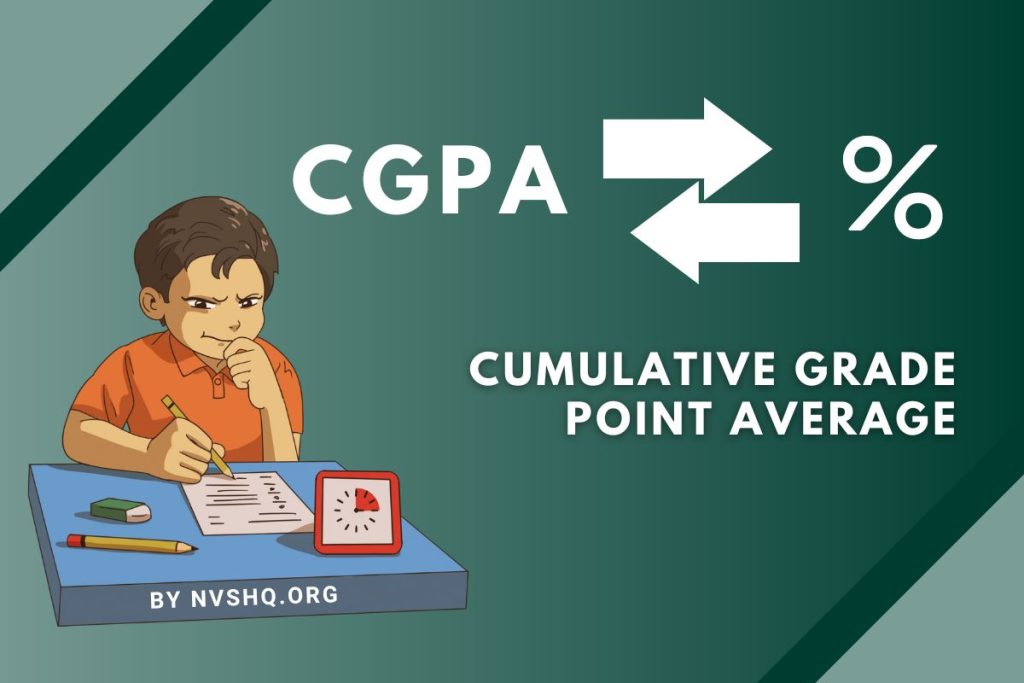What is CGPA?
CGPA to Percentage: Cumulative Grade Point Average or commonly called CGPA is a grading system which is used by boards and universities to measure the overall academic achievement of a student. Based on the performance of a student grades are given to them such as A, B, C, D, E or F.

But first to understand the Cumulative Grade Point Average we should first understand the basic concepts of GPA i.e. Grade Point Average.
What is Grade Point Average (GPA)
To fully understand the topic of Cumulative Grade Point Average or CGPA one should first understand the topic of Grade Point Average which play a vital role in calculating the Cumulative Grade Point Average. Grade Point Average is used for grades only achieved in a particular subject or one semester. When a student score a good GPA in every subject he will score a good CGPA or Cumulative Grade Point Average. If only your GPA is good then only your CGPA will be good.
Difference between Cumulative Grade Point Average (CGPA) and Grade Point Average (GPA)
Grade Point Average refers to the subject-wise score while Cumulative Grade Point Average refers to the average Grade Point Average obtained by the students in all the subjects. In the end average grade, points are calculated for all the subjects and a final Cumulative Grade Point Average is calculated and awarded to the students. Where the Grade Point Average is for a short interval of time like for a single semester or a particular subject, the Cumulative Grade Point Average is for a longer duration like it covers the score of a particular class or whole academic session.
How to calculate Cumulative Grade Point Average or CGPA
In CBSE five subjects are compulsory and termed S1, S2, S3, S4, and S5. Now the grade points are calculated as the Total of the grades obtained in all five subjects.
GRADE POINTS= S1+S2+S3+S4+S5
Now to calculate the Cumulative Grade Point Average we have to divide the sum of these by the total number of subjects.
CGPA = Grade Points (S1+S2+S3+S4+S5)/5
For example, A student scored the following grades in each subject. Subject 1=10 , Subject 2 =10,Subject 3 =9,Subject 4=10,Subject 5 = 8
So Grade Point will be GP = 10+10+9+10+8 =47
Now, Cumulative Grade Point Average = 47/5
Cumulative Grade Point Average = 9.4
So now you have a CGPA of 9.4
How to calculate Percentage from CGPA?
Students can easily find out the percentage obtained by them from the CGPA they received and multiply it by 9.5
The formula for conversion is :
Percentage= 9.5 x CGPA
To understand it more clearly let us look at the example:
Suppose a student scored the following grades in the different subjects:
| Subject 1 | 10 |
| Subject 2 | 9 |
| Subject 3 | 8 |
| Subject 4 | 8 |
| Subject 5 | 7 |
- The sum of the Grade Points of the student is calculated. So, 10+9+8+8+7= 42
- Dividing the total with the total number of subjects that is 5.
- 42/5 =8.4
- So the CGPA of the student is 8.4
- To find out the percentage of the student all we have to do is multiply the CGPA by 9.5, i.e., 8.4 x 9.5= 79.8%
- So, the approximate percentage obtained by the student is 79.80%.
The percentage grading system is divided into different divisions of ranks. The division is as follows:
- 75% – Distinction
- 60-75% – First Division
- 50-60% -Second Division
- 40-50% – Third Division
The students can find out their percentage by comparing the CGPA from the following table:
| CGPA | PERCENTAGE |
|---|---|
| 10 | 95% |
| 9.9 | 94.05% |
| 9.8 | 93.1% |
| 9.7 | 92.15% |
| 9.6 | 91.2% |
| 9.5 | 90.25% |
| 9.4 | 89.3% |
| 9.3 | 88.35% |
| 9.2 | 87.4% |
| 9.1 | 86.45% |
| 9.0 | 85.5% |
| 8.9 | 84.55% |
| 8.8 | 83.6% |
| 8.7 | 82.65% |
| 8.6 | 81.7% |
| 8.5 | 80.75% |
| 8.4 | 79.8% |
| 8.3 | 78.85% |
| 8.2 | 77.9% |
| 8.1 | 76.95% |
| 8.0 | 76% |
| 7.9 | 75.05% |
| 7.8 | 74.1% |
| 7.7 | 73.15% |
| 7.6 | 72.2% |
| 7.5 | 71.25% |
| 7.4 | 70.3% |
| 7.3 | 69.35% |
| 7.2 | 68.4% |
| 7.1 | 67.45% |
| 7.0 | 66.5% |
| 6.9 | 65.55% |
| 6.8 | 64.6% |
| 6.7 | 63.65% |
| 6.6 | 62.7% |
| 6.5 | 61.75% |
| 6.4 | 60.8% |
| 6.3 | 59.85% |
| 6.2 | 58.9% |
| 6.1 | 57.95% |
| 6.0 | 57% |
| 5.9 | 56.05% |
| 5.8 | 55.1% |
| 5.7 | 54.15% |
| 5.6 | 53.2% |
| 5.5 | 52.25% |
| 5.4 | 51.3% |
| 5.3 | 50.35% |
| 5.2 | 49.4% |
| 5.1 | 48.45% |
| 5.0 | 47.5% |
| 4.9 | 46.55% |
| 4.8 | 45.6% |
| 4.7 | 44.65% |
| 4.6 | 43.7% |
| 4.5 | 42.75% |
| 4.4 | 41.8% |
| 4.3 | 40.85% |
| 4.2 | 39.9% |
| 4.1 | 38.95% |
| 4.0 | 38% |
How to calculate Cumulative Grade Point Average (CGPA) from Percentage?
If one wants to find out the CGPA from the percentage one can easily do that. The process of conversion of percentage into CGPA is very easy and totally opposite of the above-mentioned procedure. Here all you have to do is divide the obtained percentage by 9.5.
For example, If a student got 95% on the exam. To calculate your CGPA all you have to do is divide the percentage by 9.5 i.e.,
CGPA = 95/9.5 =10
So the CGPA will be 10.
For example, if you have got a percentage of 84.5 in the examination then your CGPA will be 84.5/9.5= 8.9.
| Marks | CGPA | Grade |
| 0-21 | 00 | E2 |
| 21-32 | 00 | E1 |
| 33-40 | 04 | D |
| 41-50 | 05 | C2 |
| 51-60 | 06 | C1 |
| 61-70 | 07 | B2 |
| 71-80 | 08 | B1 |
| 81-90 | 09 | A2 |
| 91-100 | 10 | A1 |
Why was 9.5 taken to calculate the percentage from CGPA?
CBSE examined the various previous five years’ results and determined the average marks of the applicant who scored the marks between 91 and 100. The average mark obtained was close to 95. As the corresponding grade point for the 91-100 scheme is 10, the average score was divided by 10. So 95/10 will be equal to 9.5. So 9.5 was set to convert the Grade Point into CGPA and percentage.
Advantages of CGPA
The following are advantages of the using Cumulative Grade Point Average:
- Help the students to learn freely and easily, the students are now not under any pressure to score particular marks.
- Students can focus on holistic development instead of focusing on scoring high marks.
- Attention to each of the subjects can be given by the students. Performance in each subject can be determined easily.
- Students can be easily categorised based on their performance and educators can put individual attention towards each of their pupils.
- A clear sight of strengths and weaknesses can be provided by the CGPA to students. So that they work accordingly towards their weak points.
Disadvantages of CGPA
The following are the disadvantages of CGPA :
- The Cumulative Grade Point Average (CGPA) removes the sense of healthy competition among students. As the sense of competition is removed students’ only focus is to just pass the exam.
- There is no clear boundary between the grades given and the marks scored by the students. In Cumulative Grade Point Average (CGPA) a score of 91 as well as 100 both are given a grade of A1. In grades both, the categories have scored equal grades but there is a clear difference of 9 marks between them which is a significant difference.
- In the CCE system by CBSE, there are grades for activities and project works so a student can achieve good grades by simply performing better in the project and activities and not doing much of the hard work in studies.
Cumulative Grade Point Average is the full form of CGPA.
Cumulative Grade Point Average or commonly called CGPA is a grading system which is used by boards and universities to measure the overall academic achievement of a student. Based on the performance of a student grades are given to them such as A, B, C, D, E or F.
Grade Point Average is used to for grades only achieved in a particular subject or one semester. When a student scores a good GPA in every subject he will score a good CGPA or Cumulative Grade Point Average. If only your GPA is good then only your CGPA will be good.
Grade Point Average refers to the subject-wise score while Cumulative Grade Point Average refers to the average Grade Point Average obtained by the students in all the subjects. In the end, the average grade point is calculated for all the subjects and a final Cumulative Grade Point Average is calculated and awarded to the students.
The CGPA is calculated from the GPA by adding the GPA scored in each subject and dividing it by the total number of subjects. In CBSE five subjects are compulsory and termed S1, S2, S3, S4, and S5. Now the grade points are calculated as the Total of the grades obtained in all five subjects. GRADE POINTS= S1+S2+S3+S4+S5.Now to calculate the Cumulative Grade Point Average we have to divide the sum of these by the total number of subjects.CGPA = Grade Points (S1+S2+S3+S4+S5)/5.
Students can easily find out the percentage obtained by them from the CGPA they received and multiply it by 9.5.Percentage= 9.5 x CGPA.
To find CGPA from Percentage all we have to do is divide the obtained percentage by 9.5.
The CGPA have some of its advantages:
1) Help the students to learn freely and easily, the students are now not under any pressure to score particular marks.
2) Students can focus on holistic development instead of focusing on scoring high marks.
3) Attention to each of the subjects can be given by the students. Performance in each subject can be determined easily.
4) Students can be easily categorised based on their performance and educator can put individual attention towards each of their pupils.
5) A clear sight of strengths and weaknesses can be provided by the CGPA to students. So that they work accordingly towards their weak points.
The Cumulative Grade Point Average (CGPA) removes the sense of healthy competition among students. They are highly demotivated to score less in exams. As the sense of competition is removed students’ only focus is to just pass the exam. Students often focus on achieving the grade rather than understanding the core of the subject.
There is no clear boundary between the grades given and the marks scored by the students. In Cumulative Grade Point Average (CGPA) a score of 91 as well as 100 both are given a grade of A1. In grades both, the categories have scored equal grades but there is a clear difference of 9 marks between them which is a significant difference. In the CCE system by CBSE, there are grades for activities and project works so a student can achieve good grades by simply performing better in the project and activities and not doing much of the hard work in studies.







